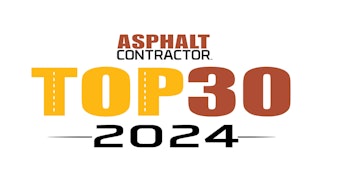
Construction technology vendors have started to release their predictions for 2024, just like clockwork.
What does not happen as reliably is a postmortem on those predictions to determine if they were accurate. Breaking with this pattern, we solicited feedback from industry leaders, experts and executives on our own predictions for the year that is now coming to a close.
What Did we NOT Predict?
In this informal conversation, Asphalt Contractor Editor Brandon Noel and I work over these predictions, and in the spirit of intellectual honesty, Noel questions, pokes and prods. Noel saves his most pointed criticism for the lack of an overt mention of construction AI in our predictions.
“If people look through your three big predictions, obviously, the biggest missing gap is AI,” Noel said. “It has been a topic of conversation between you and I personally through our work, chat and over social media. Anytime any big news happens in the AI sphere, you know, it's falling into our normal conversation. So I was surprised when I reviewed your three predictions of 2023 that AI is the big gap here. So I guess my first question to you is like, Well, how did it fly over your head 12 months ago, December of 2022.”
STREAM AND READ OUR FULL CONVERSATION
But AI has been in construction for years. At Autodesk University, the design and construction software leader seems to have had a declared major in AI in order to follow the zeitgeist, but most of the coursework was focused more on interoperability. Many of their AI mentions at the event referred to products that had already been in market but had just gotten more topical thanks to the current hype cycle. Major AI initiatives in construction have primarily predated the Chat GPT-inspired wave of AI hype. Togal was founded in 2019, for instance, and AI scheduling optimization company ALICE Technologies back in 2013. We had in 2022 already been covering AI coming to preconstruction including Zetane’s AI takeoff and estimating technology developed with Pomerleau and Patabid’s estimating software offering for HVAC contractors.
So what DID we predict?
1. Market Consolidation
Enterprise and business technology companies tend to consolidate in ownership over time. Economies of scale, the desire of technology buyers to reduce their number of vendors and manage risk by selecting established, stable vendors is one factor that will contribute to this.
More technology is coming to market for construction—some launched by established players, some from venture-funded startups and some from ambitious, rising middle-market stalwarts. The need for venture capital liquidity events, desire of larger companies to grow by acquisition, mature companies that need the injection of new capital and scale, vendor consolidation that favors major suppliers—all these dynamics will drive merger and acquisition activity.
And there was plenty of acquisition news in 2023. For example, Trackunit purchased Flexcavo for field productivity as well as a services provider to beef up installation capacity. Sage acquired Corecon for project management and precon. Procore snapped up VC-funded geographic information system (GIS) provider Unearth. Topcon acquired Digital Construction Works to create the Aptix integration platform.
“Too often, frontline workers lose valuable hours chasing information and plugging in data instead of doing the work they were trained to do,” Fastfield CEO Jeff Stay said. “This adds up to billions of dollars in lost productivity. To help address this issue, Quickbase acquired Merge Mobile and its flagship FastField Mobile Forms product. This is a big leap forward for the industry because it combines field and back-office information so teams can be more productive and drive greater impact.”
Not surprisingly, the founder of one venture-funded startup suggested the trend towards consolidation was tempered by entrepreneurial activity.
“We've seen a decent amount of consolidation in the contech space, but I think the emergence of new start-ups (with plenty of investment, to boot) have tipped the scale in favor of the market's continuing fragmentation,” Transcend Founder and CEO Adam Tank said. “It's almost a Hydra scenario where you buy one and two more pop up!”
2. Real Progress Will be Made on Construction Technology Interoperability
Because construction projects are typically executed not by a single corporate entity but by several—owners, generals, subcontractors and other vendors—processes critical to success must be handed off seamlessly between different organizations. This means requests for information, change orders, applications for payment, certificates of insurance, work-in-progress (WIP) reporting, lien waivers, amendments to contract terms and more are all making the transition in many projects into multi-company digital workflows.
Technology to collaborate on construction processes across organizational boundaries will see market development in 2023.
“When it comes to construction tech interoperability, most organizations prioritize technology over process and people,”FastField’s Stay said. “Often this means adding more tools that can make integration harder; instead, map out the people and process part first. Then you can get into connecting the core platforms, tools, and technologies you need to support your business workflow.”
While Quickbase helps contractors avoid grey work that falls between integrations with its no-code development tool, it also this year addressed interoperability with the launch of Quickbase AI, a suite of AI capabilities embedded into the Quickbase platform to expedite the development of effective applications that solve business problems. These AI capabilities are now available on a limited basis across the Quickbase platform, both for existing and prospective customers; already, more than 1,000 applications have been built using Quickbase AI.
“Interoperability has been and will continue to be a top priority in the industry,” Sage Vice President of Construction and Real Estate Dustin Stephens said. “At Sage we believe in the power of choice – giving construction businesses the flexibility to leverage the right combination of Sage and partner solutions that best meets their needs. As part of this commitment, we have worked closely with other construction technology leaders to deliver seamless integrations. We have an open API and offer a growing number of technology integrations through the Sage Intacct Marketplace.”
“It benefits everyone when technology vendors work together. We’ve long championed better integration and a more standardized approach to construction technology and are involved with organizations such as the Associated Builders and Contractors Tech Alliance and the Construction Progress Coalition. Continuing to bring stakeholders together will help us make more meaningful gains in interoperability, which is a major win for the entire industry.”
While Autodesk waved the AI flag at its Autodesk University event, most of the major project announcements had more to do with its movement towards agile interoperability. The first is internal to the Autodesk product suite. While Autodesk Construction Cloud is probably one of the more modern architectures in enterprise construction software, there is still enough room for improvement that Autodesk is announcing further investments here to get their own suite of products to work more seamlessly together.
Autodesk Docs, the common data environment running within Autodesk Construction Cloud, is becoming more central to the solution. Specifically, data in Autodesk Doc will be decoupled from the application where it was created so it can more freely move from one application to another.
In an announcement with broad implications, Autodesk also announced a new interoperability agreement with Trimble. According to an Autodesk release:
“The Trimble and Autodesk collaboration demonstrates their ongoing commitment to support open industry standards such as Industry Foundation Classes (IFC) and Construction Operations Building Information Exchange (COBie), and can enable current and prospective Autodesk and Trimble customers working on the same projects to work together seamlessly through optimized file compatibility across applications.
“Under the terms of agreement, Autodesk and Trimble will take steps to accelerate interoperability by exchanging Application Programming Interfaces (APIs) and developer tools to build and market interoperable products.”
“I'd say this was the most dialed in depending on the definition of progress,” Transcend’s Tank said. “While it's still early days, the big players have made it clear that interoperability, common data environments, and connected software throughout the lifecycle of projects will be the standard, not the exception. How long it will take is up in the air, but the wheels are in motion.”
Trimble, beyond the announced interoperability agreement, combined two predictions into one with interoperability-focused acquisitions.
“2023 was a major year for interoperability at Trimble as we started the year off with the acquisition of the company formerly known as Ryvit, a leading integration Platform-as-a-Service (iPaaS) provider that built connections between commonly used applications and data sources,” Trimble Vice President and Category GM Construction Integrations Tom Stemm said. “The acquisition accelerated Trimble’s ability to bring our vision of an open data ecosystem to life. We firmly believe this will benefit not only our own customers, but the larger construction industry as integrated data can improve efficiency, streamline workflows and enhance project visibility. Since the acquisition, Trimble has established a new construction integrations team whose purpose is to connect workflows across Trimble’s own point solutions and across point solutions from different vendors – all through Trimble Construction One. Our most recent integration is between ProjectSight and Viewpoint Vista, which follows on the heels of the Viewpoint Spectrum to ProjectSight integration, allowing contractors to easily connect their ERPs to their project management systems, which is one of the most common requests. This helps project managers stay out of the ERP and enables accounting staff to not have to do double entry in ProjectSight.”
READ MORE ABOUT TRIMBLE’S 2023 INTEROPERABILITY MOVES
3. Technology Coming to the Field
Technology for the back office of construction has had to grow in power and meet contractors’ project management and project accounting needs. But where we will see growth in 2023 is in the extension of more technology into more project sites by more contractors.
Tank took a dimmer view of this prediction.
“I think is very far off,” Tank said. “Asset management and IoT have been discussion topics for many years now—yet I only see incremental progress in adoption of these tools,” Tank said. “They haven't really hit an inflection point of any real kind IMO, especially in the water/wastewater industry.”
While facilities operation technology in Tank’s sector may not be taking off, research from IRONPROS revealed categories including field productivity software and GPS asset management software and hardware were among the most commonly budgeted construction technology expenditures heading into 2023.
Field productivity software is designed to coordinate the release of work packages to crews and employees in the field, even assigning work to specific pieces of equipment. And with the addition of GPS and telematics data, asset and fleet management software harnesses IoT data on equipment location, run time and more, informing construction and maintenance processes. GPS and Lidar machine control meanwhile drive varying degrees of automation for earthworks and other parts of project execution.
“A growing number of construction businesses are looking for solutions such as field technology to further enhance their traditional back-office systems,” Sage’s Stephens said. “Many are benefiting from the advantages of end-to-end construction cloud suites. These integrated solutions help streamline communication between the field and office and facilitate real-time collaboration and information sharing among teams. As more businesses embrace these technologies, we will see a transformation in the way construction projects are planned, executed, and managed.”
More transformational technologies are also coming to the field, including augmented reality—with vGIS launching a new augmented reality tool aimed at infrastructure construction in the course of the year. Meanwhile, an established augmented reality product from Trimble will be getting new progress tracking features and ultra-accurate augmented reality from XYZ is moving towards broader distribution in the market.
2023 also brought field technology announcements in the equipment automation space, including new and advancing field printer capabilities from Dusty Robotics, Civ Robotics and TinyMobileRobots, Built Robotics, Unicontrol and others. We also started to see more truly autonomous equipment making it to project sites beyond controlled settings like mines, including autonomous compacting with Trimble and tramming for Teleo.





























